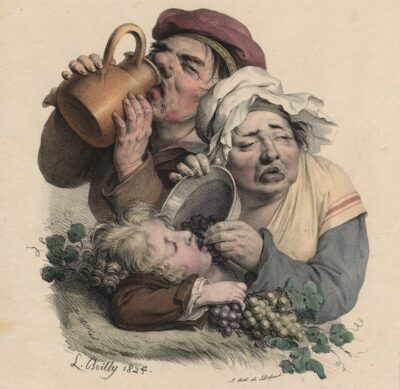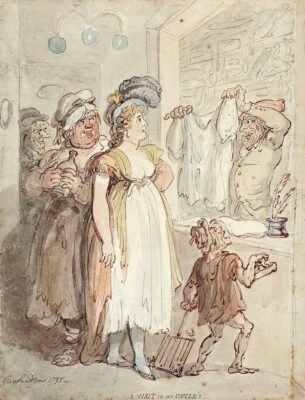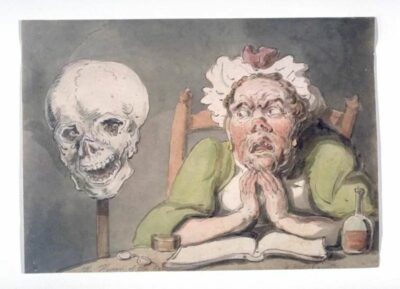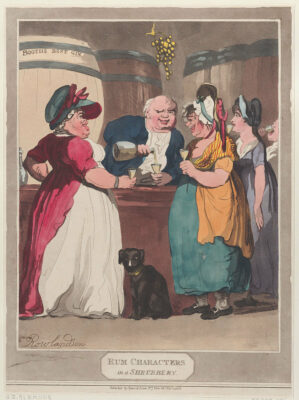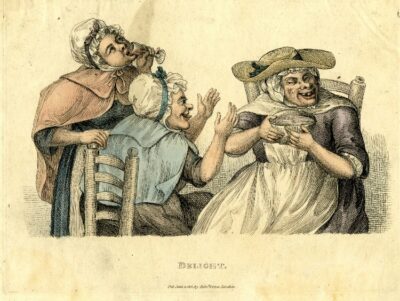Mother Gin and other ‘mothers’ in English visual culture of the era of manufactures and early industrialisation
Research goal
The aim of the research internship was to collect and systematise iconic material concerning representations of female old age associated with drunkenness in English visual culture at the turn of the 18th and 19th centuries, and to make a preliminary analysis of the process of revitalisation and regeneration of the cultural topos of anus ebria under the conditions of the developing modern culture.
The English early industrial and French revolutionary ‘culture of laughter’ saw a dynamic development of caricature and political and social satire, composed among other of the element of the depictions of old crones (e.g. Thomas Rowlandson, James Gillray, John Collier). This type of popular representations, often appearing as part of satiric visual journalism, has not been subjected to closer analysis, particularly with regard to its genesis, meaning and cultural embedding.

Research internship description
As part of a three-week stay in London, a research search was carried out at the Warburg Institute. It allowed access to the Institute’s databases and archives (iconographic material) and library. Queries were also conducted at the British Museum, the Victoria&Albert Museum and the Museum of London covering the collections of graphics and the cabinets with engravings. The undertaken activities resulted in the systematisation and compilation of iconographic material from, among others, the British and French press of the period featuring the motif of old women. This made it possible to develop the cliché of a certain type of ‘mother’, present in English culture from the 17th century onwards, associated primarily with witchcraft, innkeeping and the making of beer and gin (e.g. Mother Red Cap). We found that from the 18th century onwards, the old woman motif became particularly popular in caricature, where it appeared not only in social but also in political context (pro- and anti-revolutionary agitation, political and electoral agitation).
On the basis of the iconographic material compiled, it was possible to isolate a number of allegorical types of old women: (a) the old woman as the embodiment of the ancien regime; (b) the old woman as the embodiment of democracy; (c) the old woman as the embodiment of the republic; (d) the old woman as the embodiment of the revolution; (e) the old woman as the embodiment of the Académie française; (f) the old woman as the embodiment of censorship; (g) the old woman as the embodiment of compulsive drunkenness and moral decay.
According to the project author’s research, Mother Gin (Hogarth) type figures are a development of 16th and 17th century depictions of old ale-wifes, brewers and innkeepers (e.g. Mother Bunch, Mother Red Cap, Mother Louse), often actual figures known from the works of David Loggan, James Caulfield and other anonymous English engravers of the period. Transferred from the narratives of the pre-industrial era (the inn, the so-called merry company, the brothel, sposalizio grottesco) to the metropolitan London of the age of manufactures, they acquire, in the environment of the proletarian poor and the bourgeoisie, a new cultural fabric (e.g. Snuff and Twopenny by publisher William Davison). Old crones and ‘drunken darling mothers’ were used by caricaturists in socio-political discourse in the role of, among others, well-off women addicted to alcohol and women from the social lowlands, ridiculing the ideas they embodied (especially political ones: caricatures related to the Anglo-Irish and Anglo-French conflict). The old women-drunkards in the circumstances of the emerging British empire cease to be figures of inversion inherent to the topsy-turvy world. This ‘demythologises’ and de-eschatologises an extremely important and old cliché that is part of the narratives associated with popular culture, farce and carnival (Latin vetula). It is entered into the apparatus rhetoricus of the new era (e.g. Gin shop and Late hours T. Rowlandson). The project is a development of the research paths outlined by the author in his book Anti-Beatrice.
Related publications:
Figury śmiechu? Kobieca starość w karykaturze brytyjskiej i francuskiej końca XVIII i XIX wieku, in: Komizm historyczny i współczesny, eds. A. Karolczuk, A. Krasowska, Wydawnictwo UKSW, Warszawa 2024.
